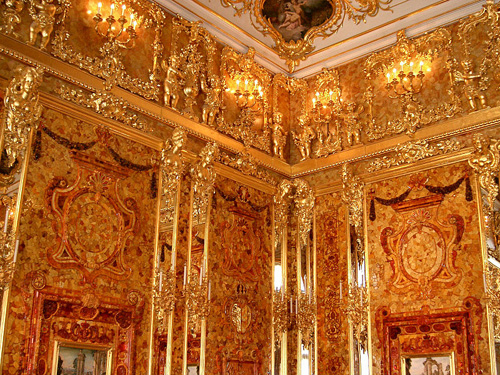
We laughed at Indiana Jones at the time. It’s only a movie, we said, watching Raiders of the Lost Ark. Treasure hunters no longer exist. Archeologists searching for the Ark of the Covenant are pure fiction.
First off, it’s true that some archeologists still hope to get hold of the Ark of the Covenant—unless it was destroyed. They look for it without lassos or guns, but they still look for it.
Second, treasure hunters do indeed exist. And one of the most coveted treasures is the Amber Room. Why? Because six tonnes of rare amber covered the walls. What’s more, the amber panels were backed by gold leaf and mirrors.
Let’s travel back to the time of the Russian tsars. In 1701, a Prussian king ordered construction of the room for the Charlottenberg Palace. In 1716, as a political move, he gave it as a gift to Tsar Peter the Great, who decided to increase the splendor of the room with additional work. Finished in 1755, the Amber Room was moved from the winter palace to the summer palace, near Saint Petersburg.
The Amber Room was so lavish and luxurious that a British ambassador in Russia described it as the eighth wonder of the world. The room became one of the country’s treasures, and Russians were very proud of it.
The October Revolution rocked the country in 1917, but the Amber Room remained intact despite much looting. During World War ll, the Soviets, aware of the Nazi appetite for art, tried to dismantle the 55 square metres of panels before the Nazis arrived in 1941. The task was impossible however because the dry amber had started to crumble. The Soviets then hid the amber behind wallpaper, but the subterfuge didn’t work. Hitler ordered his men to remove the room’s panels, an operation which required 36 hours. The Amber Room was moved to the Königsberg Castle in Germany, where it was the subject of an exhibition.
Toward the end of the war, the Soviets crossed into Germany and attacked the Nazis in Königsberg. Of course they wanted to recover the walls of their famous room. During the intense fighting and shelling, the Soviets entered the castle and discovered that the Amber Room was gone. One of the world’s singular treasures had vanished!
Soviets, treasure hunters and historians all began searching for the room. At various times it was believed to be found in a castle in the Saxony region of Germany, in a salt mine in Poland and in a shipwreck in the Baltic Sea. All for naught: debris was found, but not the panels.
Tired of searching, the Russians began reconstructing the room from photographs, drawings and watercolours. The colossal undertaking was completed in 2003 after a quarter of a century. The facing photo shows the reconstructed Amber Room.
Investigative journalists Catherine Scott-Clark and Adrian Levy conducted a lengthy investigation into the possible whereabouts of the room. Their conclusion was that the Amber Room was destroyed in a fire in the Königsberg Castle after the Germans surrendered. All the same, some still dream of finding it, even if the possibility is practically nil.
Note: Amber is a fossilized plant resin; it is not a mineral (from the ground).
References:
Le saviez-vous? Sélection du Reader’s Digest, Mille et une histoires vraies et insolites 1992, 384 pages.
Wikipedia: Amber Room
Thriller de Jérôme Bucy, La chambre d’ambre, Belfond, 286 pages, Paris 2008.
Photo: Jeanyfan (Wikipedia Commons)
